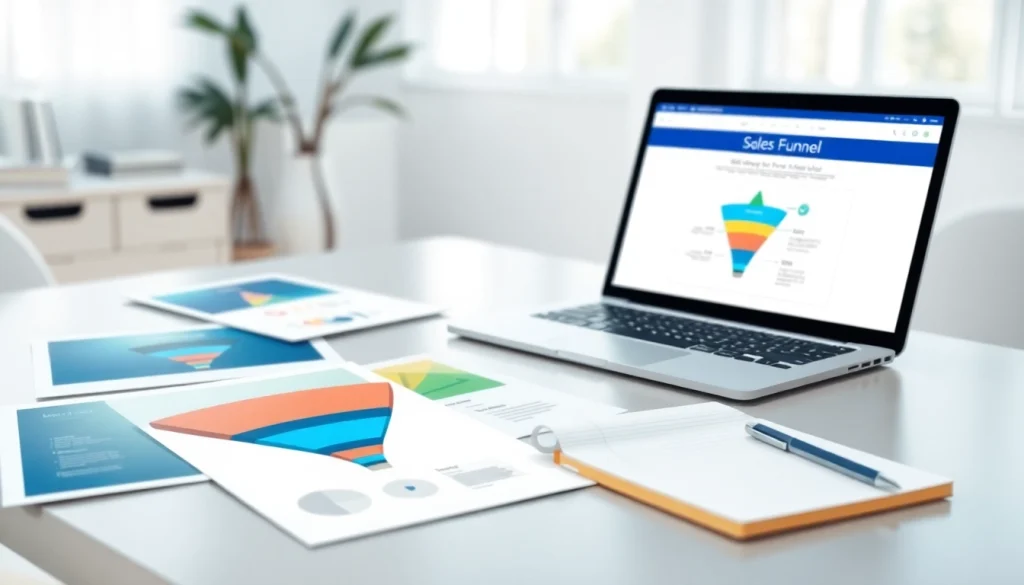
Understanding Funnel Templates
What are Funnel Templates?
Funnel templates are pre-designed layouts that help businesses create sales funnels more efficiently. They provide a structured approach to guiding potential customers through the buying journey, from awareness to conversion. Think of a funnel as a visual representation of the steps a customer goes through before making a purchase. By utilizing these templates, businesses can save time and ensure they include all necessary components for a successful sales process.
These templates come in various formats and can be adapted to different platforms and specific business needs. With the right Funnel templates, every business can create visually appealing and strategically effective paths that maximize conversions.
Benefits of Using Funnel Templates
Using funnel templates can significantly enhance the efficiency of your marketing and sales strategies. Here are several key benefits:
- Time-Saving: Funnel templates drastically reduce the time required to create a sales funnel, providing a ready-made structure to build upon.
- Consistency: They ensure a consistent design and messaging strategy, reinforcing brand identity throughout all customer touchpoints.
- Data-Driven Design: Many templates are created based on data and testing, which means they often follow best practices for layout and user flow that can lead to higher conversion rates.
- Customization Options: Despite being pre-designed, templates allow for customization, enabling businesses to tailor content and visuals to their specific audience.
- Focus on Strategy: Templates help marketers and business owners focus more on strategy and performance rather than getting bogged down in design elements.
Types of Funnel Templates Available
Funnel templates are not one-size-fits-all; they cater to various stages of the customer journey and different business models. Common types of funnel templates include:
- Lead Generation Funnels: Designed to capture leads through emails or contact information, often involving offer incentives.
- Sales Funnels: They aim to convert potential customers into paying customers, directing visitors toward purchasing products or services.
- Webinar Funnels: Used specifically for promoting upcoming webinars and encouraging sign-ups from interested participants.
- Product Launch Funnels: Focused on generating buzz and sales around a new product offering.
- Retargeting Funnels: Designed to re-engage previous website visitors or customers to encourage repeat purchases.
Key Elements of High-Converting Funnel Templates
Design Best Practices for Funnel Templates
When it comes to funnel design, several best practices should be considered to ensure high conversion rates:
- Clear and Concise Messaging: Ensure your messaging is straightforward and communicates your value proposition clearly.
- Visual Hierarchy: Utilize size, color, and layout to guide the viewer’s eye toward the most important elements such as CTAs (Call to Action).
- Responsive Design: Ensure templates are mobile-friendly since a significant amount of traffic comes from mobile devices.
- Consistent Branding: Employ your business’s brand colors, fonts, and logos to maintain brand identity throughout the funnel.
- Testimonials and Social Proof: Incorporate reviews or statistics that enhance credibility and help in building trust with potential customers.
Essential Pages in Funnel Templates
High-converting funnel templates typically include several essential pages:
- Landing Page: The first point of interaction, designed to capture the visitor’s attention and drive action.
- Sales Page: Focused on providing detailed information about the product/service, including features, benefits, and pricing.
- Thank You Page: Acknowledge a user’s action (like signing up or making a purchase) and set up the next steps.
- Cart Page: Where users finalize their purchases; it’s critical to ensure this page is clear and free of distractions.
- Upsell Page: Offering additional products or services after the initial purchase to increase overall sales.
Integrating Calls to Action in Funnel Templates
Calls to action (CTAs) are integral to funnel templates; they guide users on what to do next. Here are strategies for effective CTAs:
- Strategic Placement: Position CTAs prominently on pages where users will make decisions, like landing and sales pages.
- Clear Language: Use action-oriented language such as “Get Started,” “Download Now,” or “Join Today.”
- Visual Distinction: Ensure CTAs are visually distinctive through use of color or size to catch the user’s attention.
- Value Proposition: Include a brief explanation of what the user gains by taking action (e.g., “Get a free trial” or “Unlock exclusive content”).
How to Choose the Right Funnel Templates for Your Business
Identifying Your Target Audience
Before selecting a funnel template, it’s crucial to understand who your target audience is. Consider demographics, preferences, and behaviors. Tailoring your templates to resonate with these characteristics will enhance engagement and conversion rates.
Developing customer personas can aid in visualizing different segments of your audience, thereby tailoring your funnel efforts appropriately.
Evaluating Funnel Templates Based on Objectives
Your business goals will heavily influence which funnel templates to choose. Some aspects to consider include:
- Type of Product/Service: Consider the complexity and lifecycle of your offerings. Some products may require more detailed explanations or a longer customer journey.
- Sales Goals: Align funnel objectives with overall sales goals, whether that involves increasing lead generation, improving retention, or boosting one-time sales.
- Budget Constraints: Evaluate templates not just based on aesthetics but also cost-effectiveness in driving results that match your financial expectations.
Customization Options for Funnel Templates
While pre-designed funnel templates can simplify the setup process, flexibility for customization is essential. Here are some key aspects to consider:
- Content Adaptations: Ensure templates allow for text and image modifications to speak directly to your audience.
- Branding Capabilities: Check if template designs can be easily adjusted to fit your specific branding.
- Integration with Tools: Ensure the selected templates can be integrated with your existing tech stack and marketing tools for maximum efficiency.
Implementing Funnel Templates
Step-by-Step Guide to Setting Up Funnel Templates
Here’s a structured process to guide you in implementing your chosen funnel templates:
- Select Template: Choose a template that aligns with your business goals and audience needs.
- Customize Your Content: Adjust text, images, and other elements to fit your business’s unique voice and offer.
- Setup Integration: Connect necessary tools, such as email marketing software and payment gateways, to ensure smooth operations.
- Test the Funnel: Before launching, run tests to check the functionality of links, forms, and payment processes.
- Launch: Once everything is checked, launch your funnel and start directing traffic to it.
Testing and Optimizing Funnel Templates
Testing is crucial to ensure your funnels perform at their best. A/B testing can provide valuable insights into how different elements impact user behavior. Consider testing:
- Headlines: See which headlines attract more clicks and engagement.
- Images: Different visuals may resonate differently with your audience.
- CTAs: Experiment with different wording and placements for your CTAs to see what converts best.
Optimization should be an ongoing process. Regularly review customer feedback and conversion data to enhance the template continually.
Common Pitfalls to Avoid with Funnel Templates
When implementing funnel templates, some common mistakes can hinder performance:
- Overcomplicating Design: A cluttered funnel can confuse visitors. Make sure to keep design elements clean and straightforward.
- Neglecting Mobile Users: Always preview your funnel on mobile devices to ensure functionality and aesthetic appeal.
- Ignoring Analytics: Failing to track performance data limits the ability to make informed adjustments. Always analyze metrics.
Measuring Success with Funnel Templates
Key Performance Indicators for Funnel Templates
Performance measurement is vital to understanding the effectiveness of your funnel templates. Key performance indicators (KPIs) to watch for include:
- Conversion Rates: Measure the percentage of visitors who complete the desired action (like signing up or making a purchase).
- Traffic Sources: Track where your visitors are coming from to determine which channels are most effective.
- Time on Page: Assess how long users stay on your funnel pages to gauge engagement levels.
- Drop-off Rates: Identify where users exit the funnel to uncover potential issues or points of friction.
Tools for Analyzing Funnel Templates Performance
Utilizing the right tools can simplify the analysis process. Consider these options:
- Google Analytics: Gives comprehensive insights into website traffic and user behavior.
- A/B Testing Tools: Platforms like Optimizely help in testing variations of funnel elements.
- Heatmap Tools: These tools visually represent user interaction, showing where users click most often.
Iterating Based on Data from Funnel Templates
Data-driven iteration is essential for continuous improvement. Use insights gathered from analytics to tweak various aspects of your funnel:
- Refining CTAs: Adjust copy and placement based on what’s driving engagement and conversions.
- Improving Content: Update the copy, visuals, or offers based on what resonates most with your audience.
- Testing New Templates: Experiment with new funnel templates to see if they yield better results.
Ultimately, the goal is to create a cycle of ongoing improvements that enhance user experience and drive conversions.






